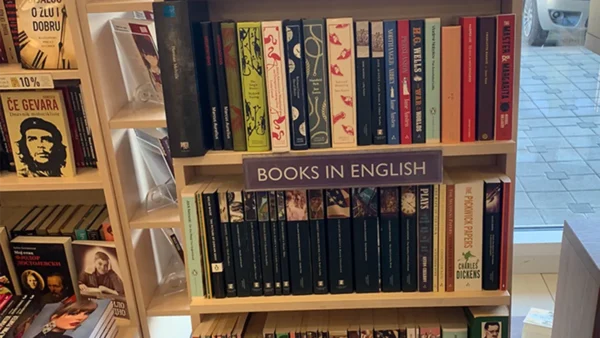Update: I interviewed Preeta Samarasan about this book and her writing in general – to listen to the interview, click here.
This book grew on me. At first I found the amount of detail overwhelming, and thought the pace was too slow. Gradually, though, I got used to the style. By the end, I thought it was one of the best books I’ve read in quite a long time.
It’s an interesting book in that it illuminates the politics of post-colonial Malaysia and the tensions of race and class, and yet the action takes place almost entirely inside a single house. It’s called the Big House, and the family living in it is wealthy but absolutely dysfunctional. It’s dysfunctional, though, in subtle ways – this is not a book of beatings and rapes and other traumatic events. It’s a book about slower, more corrosive forms of abuse: secrets, lies, pretence, bitterness, the absence of affection or, perhaps worse, its sudden withdrawal.
Not a huge amount happens in the book, and what does happen is described in minute detail from the perspectives of each different member of the family. Although this tried my patience early on, the effect towards the end of the book was astonishing. I felt as if I knew every character inside-out, and understood their motivation for being the way they were. Although the members of the family do some pretty horrible things to each other, we come to understand exactly why, and so nobody is portrayed as a villain.
Not too many characters are sympathetic either. For me (although I suspect this will be different for different readers), the servant girl Chellam and the occasional visitor called Uncle Ballroom are the ones I sympathised with most. As relative outsiders to the family, they were at first welcomed as providing an alternative to the bitterness and hatred within it, but then resented for speaking the truth in an environment where fragile lies are what life in the Big House is built on.
The novel spans decades of post-colonial Malaysian history, mostly from the 1960s up to about 1980, but outside events are touched on only briefly. This suggested a child’s view of the world to me, where the Big House is the centre of the world and outside events are an occasional interruption. Although the narrator is omniscient and gives the perspectives of all the characters at various stages, the claustrophobic focus on the house above all else made me see the novel more through the eyes of the children in the family, particularly the youngest Aasha (who, incidentally, reminded me a lot of Briony in Ian McEwan’s Atonement). Certainly the father, a lawyer and one-time aspirant to political office, spends most of his time outside the house, and yet we rarely see what he sees. There’s a short passage where he is with his mistress in her home, but mostly he is only ever seen where the children see him, sitting at the dinner table inside the Big House. Whatever the reason for this relentless focus on the house, it does succeed in creating a world with known parameters, a world in which the reader at the end feels as if they know and understand everything within that world.
Strangely, the political side of the book is effective too. Although I’m sure it’s not meant as such a crude allegory, the lies within the family do seem to parallel the lies within the country. The multi-ethnic cardboard cutout figures welcoming people to Malaysia in the airport scene at the end are wonderful symbols of a country in which truth can never be told for fear of unearthing painful memories, the same problem that imprisons the family. Nothing is said overtly in the novel about race and class, and yet the brief mentions of race riots and killings are enough to set the scene, and the treatment of Chellam is central to the dishonesty of the family.
I would highly recommend this book. Usually I prefer a more spare, ‘minimalist’ writing style (e.g. Cormac McCarthy’s The Road). This is the other end of the spectrum from that – very ornate, effusive, highly descriptive – and yet I am very glad I persevered. I think the characters in this book are among the most fully realised I’ve come across, highly nuanced and utterly believable. This is Samarasan’s debut novel, and I will definitely be reading whatever she comes up with next.
Click here to read more of my book reviews. Or click here to read other people’s reviews of Evening is the Whole Day on Amazon.



There are 7 comments
I bought this book when it was first published. Then promptly forgot about it. I’m going to read it soon. thanks.
Hi Kinna,
I can sympathise – I have a whole pile of books I’ve bought and not read yet, and then when I want to read a new book, I forget about them and go and buy yet another book! Glad I was able to remind you about this one – do stop by when you’ve read it, as I’d be interested to hear what you thought of it.
All the best
Andrew
This is a great review. Contrary to your experience, I was enchanted from the beginning (even though I myself am not a fan of too descriptive writing). And what a wonderful thing she did with the character of Uncle Ballroom!
Hi Anna,
Thanks, Anna! You know, I’ve reread the book a couple of times since I wrote this review, and now I do find myself enchanted from the beginning. Maybe that’s because I know the treat I have in store, and I trust Preeta Samarasan so I stick with her through the description of the shape of Malaysia, etc. It really works for me now, much more than it did the first time.
I agree, Uncle Ballroom is a very compelling character. So are the others, in different ways. One of the things I love about this book is the way the different characters play off each other and are each important, so that there’s no clear protagonist: it’s really the dysfunctional family itself that’s the protagonist, and each member plays such an important role.